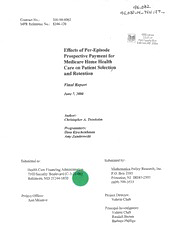Table Of ContentContractNo.: 500-94-0062
MPRReferenceNo.: 8246-126
CMSLibrary
91 C2-07-13
Ba7l5t0i0moSriee,cuMriDty2Bl1v2d4.4
EffectsofPer-Episode
ProspectivePaymentfor
MedicareHomeHealth
CareonPatientSelection
andRetention
FinalReport
June7,2000
Author:
ChristopherA.Trenholm
Programmers:
DinaKirschenbaum
AmyZambrowski
Submittedto: Submittedby:
HealthCareFinancingAdministrjjj^ MathematicaPolicyResearch,Inc.
7500SecurityBoulevard(C-3-21-06) P.O.Box2393
Baltimore,MD21244-1850 | Princeton,NJ 08543-2393
(609)799-3535
ProjectOfficer: ProjectDirector:
AnnMeadow ValerieCheh
PrincipalInvestigators:
ValerieCheh
RandallBrown
BarbaraPhillips
ACKNOWLEDGMENTS
Inpreparingthisreport,Ireceivedsupportandassistancefrommanycolleagues,forwhichIam
grateful. ValerieChehandRandallBrowncontributedtheirpolicyexpertiseandofferedthoughtful
commentsthroughouttheresearch;LyleNelsonprovidedanexcellentcriticalreview;Barbara
Phillips,ValerieCheh,andJenniferSchorecontributedtothebackgroundchaptersthroughprevious
work;CindyMcClure adeptlyproducedthereport;andRoyGrishamprovidedskillededitorial
supportwithhelpfromPatriciaCiaccio. AimMeadowatHCFAprovidedveryusefulcomments
toanearlierdraftofthereport. Anyerrorsoromissionsinthisreportaremyown.
iii
CONTENTS
Chapter Page
EXECUTIVESUMMARY xi
I THEPER-EPISODEHOMEHEALTHDEMONSTRATION
ANDEVALUATION
1
A. THEMEDICAREHOMEHEALTHBENEFIT 2
B. THEPER-EPISODEDEMONSTRATION 4
1. DemonstrationPaymentandIncentives 6
2. OtherDemonstrationProcedures 9
C. GUIDETOTHERESTOFTHISREPORTANDOTHER
EVALUATIONREPORTS 12
II DATA 13
A. THEMAINDATAFILE 15
1. CreatingPatientRecords 15
2. AvailableVariables 15
B. SAMPLETOSTUDYSELECTIONBASEDONEXPECTED
SERVICEUSE(VISITS) 19
1. CreationoftheAnalysisSample 19
2. OutcomeVariables 24
3. ControlVariables 26
C. SAMPLETOSTUDYSELECTIONBASEDONEXPECTED
PER-VISITCOSTS 29
1. CreatingtheAnalysisSample 29
2. OutcomeVariables 30
3. ControlVariables 33
D. SAMPLETOSTUDYRETENTION 34
1. CreatingtheAnalysisSample 34
2. OutcomeVariables 35
3. ControlVariables 41
V
CONTENTS(continued)
Chapter Page
II E. SUMMARY 44
(continued)
III METHODS 45
A. ESTIMATINGOVERALLIMPACTSONPATIENT
SELECTION 45
1. RegressionModelstoInvestigateSelectionBasedonExpected
ServiceUse 45
2. PotentialLimitationsoftheAnalysisonUseSelection 47
3. RegressionModelstoInvestigateSelectionbyExpected
Per-VisitCosts 50
4. PotentialLimitationsoftheAnalysisonCostSelection 52
B. ESTIMATINGOVERALLIMPACTSONPATIENT
RETENTION 53
1. ChoosingtheProperUnitofAnalysis 53
2. RegressionModels 55
3. PotentialLimitationsoftheAnalysisonPatientRetention 56
C. ESTIMATINGSUBGROUP IMPACTS 57
D. ROBUSTNESSTESTS 59
1. ComparingImpactsBetweenDemonstrationYears 60
2. SampleWeights 61
3. Outliers 62
E. STATISTICALPRECISIONANDOTHERMEASUREMENT
ISSUES 63
21.. HDyepsoitghneEsfifsecTtesstsfortheImpactEstimates 6634
3. Weighting 65
IV IMPACTOFPROSPECTIVEPAYMENTONPATIENT
SELECTIONANDRETENTION 67
A. EXPECTEDEFFECTS 67
vi
CONTENTS(continued)
Chapter Page
IV B. IMPACTSONPATIENTSELECTION 70
(continued)
C. IMPACTSONPATIENTRETENTION 78
D. ROBUSTNESS 81
1. Findings 82
2. Overview 86
V SUBGROUPIMPACTS 87
A. EXPECTEDIMPACTS 88
B. ESTIMATEDIMPACTSAMONGSUBGROUPS 90
C. SUMMARY 98
VI CONCLUSIONS 99
A. KEYFINDINGS 99
B. LIMITATIONSOFTHEANALYSIS 101
C. POLICYIMPLICATIONS 103
REFERENCES 105
APPENDIXA: SUMMARYOFCASE-MIXADJUSTMENT
FORPAYMENTSDURINGTHE
DEMONSTRATION 107
APPENDIXB SUMMARYOFTHEVARIABLEUSED
: TOACCOUNTFORPREEXISTINGDIFFERENCES
INAGENCYPRACTICEPATTERNS 113
APPENDIXC: VARIABLECONSTRUCTIONFORTHE
ANALYSISOFSELECTIONBASED
ONEXPECTEDSERVICEUSE 117
APPENDIXD: DETAILEDSUBGROUPTABLES 125
vii
TABLES
Table Page
II.1 SELECTEDVARIABLESAVAILABLEFORTHEANALYSIS
OFPATIENTSELECTIONANDRETENTION 16
11.2 DISTRIBUTIONOFTHEUSESELECTIONSAMPLE,BYEPISODE
COUNTANDDEMONSTRATIONYEAR 22
11.3 DISTRIBUTIONOFUSESELECTIONSAMPLEACROSS
AGENCIES,BYTREATMENTSTATUS 23
11.4 OUTCOMEVARIABLESTOEXAMINEUSESELECTION 25
11.5 WEIGHTEDMEANS,ANDTESTSFORDIFFERENCESAMONG
TREATMENTANDCONTROLGROUPS,FORTHE
EXPLANATORYVARIABLESINTHEUSESELECTION
ANALYSISREGRESSIONMODELS 27
11.6 COSTSELECTIONSAMPLE:DISTRIBUTIONOFADMISSIONS
(EPISODESTARTS)ONWHICHAGENCY-LEVELVARIABLES
AREBASED,BYTREATMENTSTATUS 31
11.7 OUTCOMEVARIABLESTOEXAMINECOSTSELECTION 32
11.8 DISTRIBUTIONOFTHERETENTIONSAMPLEACROSS
AGENCIES,BYTREATMENTSTATUS 36
11.9 OUTCOMEVARIABLESTOEXAMINEPATIENT
RETENTION 38
II.1 WEIGHTEDMEANS,ANDTESTSFORDIFFERENCESAMONG
TREATMENTANDCONTROLGROUPS,FORTHE
EXPLANATORYVARIABLESINTHERETENTION-ANALYSIS
REGRESSIONMODELS 39
IV.1 PERCENTAGEOFPATIENTSADMITTEDWITH
SELECTEDCHARACTERISTICSTHATPREDICTASIGNIFICANT
CHANGEINSERVICEUSEDURINGTHEAT-RISKPERIOD 71
IV.2 PREDICTEDLEVELOFHOMEHEALTHUTILIZATIONDURING
THEAT-RISKPERIOD,BASEDONPATIENTCHARACTERISTICS
OBSERVEDATADMISSION 73
ix
TABLES(continued)
Table Page
IV.3 PREDICTEDLEVELOFHOMEHEALTHUTILIZATIONWITHIN
THEMAJORCASE-MIXCATEGORIES 76
IV.4 CHANGE INTHEPROPORTION OFPATIENTSSERVED
WITHPOTENTIALLYHIGHPER-VISITCOSTS(FROMTHE
PREDEMONSTRATIONTOTHE DEMONSTRATION) 77
IV.5 CUMULATIVERATEOFTRANSFERDURINGTHEYEAR
AFTERADMISSION 79
IV.6 RATEOFTRANSFERANDOTHERAGENCYINVOLVEMENT
BYONEYEARAFTERADMISSION,UNDERALTERNATIVE
MEASURES 80
IV.7 COMPARISONOFIMPACTSONKEYPATIENTSELECTION
ANDRETENTIONMEASURESUNDERALTERNATIVE
EMPIRICALSPECIFICATIONS 83
IV.8 COMPARISONOFIMPACTSONKEYPATIENTSELECTION
AND RETENTIONMEASURESBETWEENYEAR1ANDYEAR
2OFTHEDEMONSTRATION 84
V.1 IPAMTPIAECNTTOSFEPLEERC-TEIPOINSOADNEDPRREOTSEPNETCITOINVEMPEAASYUMREENST,OBNYKEY
WHETHERTHEAGENCYISFOR-PROFITORNONPROFIT 91
V.2 IMPACTOFPER-EPISODEPROSPECTIVEPAYMENTONKEY
PATIENTSELECTIONANDRETENTIONMEASURES,BY
WHETHERTHEAGENCYISHOSPITAL-BASEDORFREESTANDING ...92
V.3 IMPACTOFPER-EPISODEPROSPECTIVEPAYMENTONKEY
PATIENTSELECTIONANDRETENTIONMEASURES,BY
WHETHERTHEAGENCYISSMALLORLARGE 95
V.4 IMPACTOFPER-EPISODEPROSPECTIVEPAYMENTONKEY
PATIENTSELECTIONANDRETENTIONMEASURES,BY
WHETHERTHEAGENCYHASAHIGH-USEORLOW-USE
PRACTICEPATTERN ^6
V.5 IMPACTOFPER-EPISODEPROSPECTIVEPAYMENTONKEY
PATIENTSELECTIONANDRETENTIONMEASURES,BY
WHETHERTHEAGENCYISACHAINMEMBER 97
X
EXECUTIVESUMMARY
Aspartofitsongoingefforttostudymethodsofprovidingmorecost-effectivecare,theHeahh
CareFinancingAdministration(HCFA)implementedthePer-EpisodeHomeHeahhProspective
PaymentDemonstration. Underthedemonstration,homeheahhagenciesreceivedafixed,lump-
sumpaymentforthefirst120daysofeachepisodeofcareprovidedtoMedicarebeneficiariesand
apredeterminedrateforeachvisitthereafter. Byallowingagenciestoretainmostofanysurplus
paymentsovercost,prospectivepaymentgivesagenciesafinancialincentivetoprovidehomehealth
careinamorecost-efficientmannerthanundertraditionalcost-basedreimbursement.
Inthisreport,weexaminedatafi-omthefirsttwoyearsofthedemonstrationtoestimatethe
possibleeffectsofprospectivepaymentonagencies'selectionandretentionofhomehealthpatients.
Ourkeyfindingisthatprospectivepayment(asdefinedbydemonstrationrules)didnotsignificantly
altertheselectionorretentionofpatientsrelativetoasystemofcost-basedreimbursement.
Prospectivelypaidagenciesadmittedpatientswithsimilarlevelsofexpectedserviceuseandwith
similartypesofmedicalconditionsandothercharacteristicshighlypredictiveoffutureservice
needs.Inaddition,theirratesoftransferweresimilarandquitelow;byoneyearafteradmission,
prospectivelypaidagencieshadtransferredonlyaboutthreepercentoftheirpatientstoanother
agency.
DEMONSTRATIONOVERVIEW
Ninety-oneagenciesinfivestatesenteredthethree-yeardemonstrationatthestartoftheir1996
fiscalyears. Priortothestartofthedemonstration,theparticipatingagencieswererandomly
assignedtoeitherthetreatmentorthecontrolgroup. Agenciesassignedtothetreatmentgroupwere
reimbursedunderthedemonstration'sprospectivepaymentmethod,whilethoseassignedtothe
controlgroupcontinuedtobereimbursedundercost-basedreimbursement(thepaymentmethod
Medicareusedforallhomehealthagencieswhenthedemonstrationbegan).
Foreachpatientadmittedtohomehealthcare,treatmentgroupagenciesreceivedalump-sum
paymentforthefirst120daysofhomehealthcare,regardlessofthenumberofvisitsprovidedor
theircost. (Durablemedicalequipment,nonroutinemedicalsupplies,andPartBambulatory
servicescontinuedtobereimbursedatcost.) Theamountoftheper-episodepaymentwasbasedon
eachagency'sowncostsinthefiscalyearimmediatelyprecedingitsentryintothedemonstration,
adjustedforchangesinitscasemixandforinflation. Anagencycouldreceiveanewper-episode
paymentforagivenMedicarebeneficiaryonlyafterthe120-day"at-risk"periodhadendedanda
45-daygapinserviceshadtakenplace. Foreachvisitaftertheat-riskperiodthatdidnotbegina
newepisode,treatmentagenciesreceivedafixedpaymentthatvariedbytypeofvisitandwasagain
basedontheagency'sownpredemonstrationcosts.
xi
HYPOTHESESANDMETHODS
Ourbasichypothesiswasthatagenciesreceivingprospectivepaymentwouldtrytoobtaina
lower-costpatientmixinordertobringtheirepisodecostsbelowtheper-episodepayment.Two
particularchangesinpatientselectionwerehypothesized. Thefirstwasthatagencieswouldreduce
theirshareofadmissionsexpectedtobehighutilizersofcare;thesecondwasthattheywouldreduce
theshareofadmissionsexpectedtohaverelativelyhighper-visitcosts. Withrespecttopatient
retention,wehypothesizedthatprospectivelypaidagencieswouldraisetheirtransferratesinan
efforttodischargehigh-costpatientsmorequickly.
Dataforouranalysiscomefromseveralsources. Medicareclaimsdataallowedforthecreation
ofa"mainfile"ofpatient-levelrecordsforeachepisodeofcarebegunbetweenanagency'sstartin
thedemonstrationandAugust1997. Thesedataalsoprovidedextensiveinformationonthetiming
andnatureofpatients'serviceuse,whichwasusedinconstructingoutcomevariablesthatmeasured
agencyretentionrates andpatientselectionpatterns. Datafromthedemonstration'squality
assurancecontractorprovidednurses' assessmentsofpatientsathomehealthadmission. In
conjunctionwiththeserviceusedatafromMedicareclaims,theseassessmentswereusedtocreate
ouroutcomevariables,whichmeasuredagencyselectionpatterns.Additionaldatasourcesprovided
extensiveinformationonagencyandareacharacteristics,usedprincipallytoconstructcontrol
variablesforourregressionmodelsanddefinekeysubgroups. Thesesourcesincludedagencycost
reportsforboththepredemonstrationanddemonstrationperiods,datafromtheAreaResourceFile,
andselecteddatafromthedemonstration'simplementationcontractor.
Ouranalysisusedthreesamples,eachderivedfromthemainfileofpatientrecords. These
samplesvariedconsiderablyinsizeandcompositionduetoacombinationofmissingdataand
differencesindatarequirements. Totheextentthatwecouldexaminewhetherourfindingswere
sensitivetothesemissingdata,theyappeartobehighlyrobust.Ourfirstsamplewasusedtoanalyze
whethertreatmentagencies selectedpatientsbased ontheirexpectedserviceuse. This"use
selection"sampleincluded54,353observations(episodestartsduringthedemonstration)in84
agencies. Weusedthesecondselectionsampletoanalyzewhethertreatmentagenciesselected
patientsbasedontheirexpectedcostspervisit. This"costselection"sampleincluded109,594
observationsin87agencies. Finally,the"retenfion"sample,whichweusedtoexaminewhether
treatmentagenciesweremore likelytotransferpatients, included 86,448 observationsin79
agencies. Mostoftheanalysisofretentionfocusedonasubsample of52,133 observations
correspondingtoadmissionsindemonstrationyear 1 becauseofalimitedobservationperiod
(postadmission)inyear2.
Ordinary least squaresmodels and logitmodels were usedto estimate programeffects,
controllingforpreexistingdifferencesbetweentreatmentandcontrolagencies. Observationswere
weightedsothateachagencywasrepresentedequallyintheanalysis. Standarderrorsofimpact
estimateswerecalculatedusingspecialsoftwaredesignedtoaccountfortheeffectsofsample
clusteringandweighting,soastoavoidoverstatingtheprecisionoftheestimates. Sensitivitytesting
ofourregressionestimatesshowedthattheywerenotsensitivetotheweightingschemeortooutlier
values.Theimpactestimatesalsodisplayednochangebetweenthefirstandsecondyearsofthe
demonstration.
xii
FINDINGS
NoSignificantChangeinAccessforHigh-CostPatients
Per-episodeprospectivepaymentdidnotleadagenciestoavoidpatientsexpectedtobehigh
utiHzersofcare. Treatmentagenciesw^erenolesslikelytoadmitapatientwithaseriousmedical
condition,limitationsinactivitiesofdailyliving,orotherconditionspredictiveofhigher-than-
averageserviceneeds. Inaddition,basedontheirobservedcharacteristicsatthestartofanepisode,
theaveragepatientinatreatmentagencywaspredictedtousealmostexactlythesamelevelof
servicesduringtheat-riskperiodastheaveragepatientinacontrolagency(seeFigure1).
Wealsofindnoevidencethatthedemonstrationaffectedtheadmissionofpatientsexpected
tohaverelativelyhighcostspervisit. Forexample,thedemonstrationhadnosignificanteffecton
theproportionofpatientsadmittedfromhighlyruralareasorfromareaswithahighpercentageof
non-English-speakinghouseholds.
PossibilityofSlightFavorableSelectionAmongReadmissions
Amongtheroughly1in10patientswithmultipleepisodesofcareinthesameagency,those
readmittedtotreatmentagencieswerefoundtohaveslightlylowerpredictedserviceuse(on
average)thanthosereadmittedtocontrolagencies. Whileconsistentwiththeincentivestoselect
a lower-cost patient mix under the demonstration, this difference appears to be due to an
underestimateofpredictedserviceuseamongthetreatmentgroupratherthanachangeinselection
practicesontheirpart. Nevertheless,wecannotrejectthepossibilitythatasmalldegreeof
favorableselectiontookplaceamongreadmissionstothetreatmentgroup,particularlysincethey
aresuchanattractivetargetfortheseefforts.
TransferRatesRemainedLowandUnchanged
Agenciesalsodisplayednogreaterpropensitytotransferhigh-usepatientsaftertheywere
admitted. Ineachmonthafteradmission,theratesofpatientswitchingfi-omdemonstrationagencies
toanotherdemonstrationagencywerelowandnearlyidenticalfortreatmentandcontrolagencies.
Byoneyearafteradmission,forexample,3.2percentofpatientshadbeentransferredfromcontrol
agencies,comparedto2.9percentfromtreatmentagencies(Figure1).
FindingsWereRobustAcrossDifferentAgencyTypes
Impact estimates for selected agency subgroups underscore the main finding that the
demonstrationhadno adverseeffectsonaccessto care forhigher-costpatients. Forthe 10
subgroups investigated, mostoftheestimated impactsonpatientselectionorretentionwere
insignificant. Moreover,amongthesetofsignificantimpacts,nonewereconsistentwiththe
incentivestoselectorretainalower-costpatientmix.
xiii

